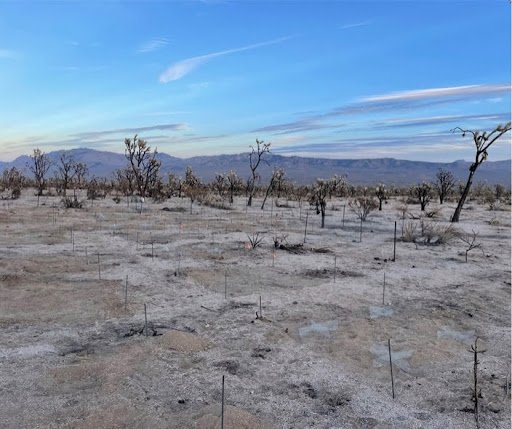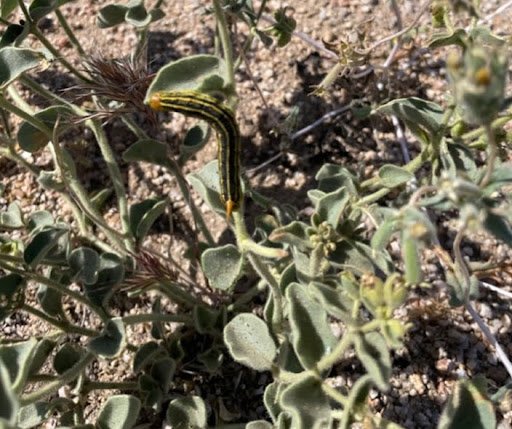Dome Fire Restoration Project
Mojave Desert, California
By Riley Scaff, Project Lead
The Dome Fire in August, 2020 was devastating to the Cima Dome area, a climate refuge for the endangered Joshua Tree and the site of one of the densest Joshua Tree forests in the world. However, it also provided an opportunity to investigate the impacts of fire on a fragile ecosystem, and how to promote its recovery while conserving an iconic symbol of the California desert.
During the fall of 2020 and spring of 2021, I began communicating with researchers at different organizations to design a restoration study for this area. I had fantastic correspondence with individuals such as Molly McCormick (ecologist, USGS Southwest Biological Science Center), Drew Kaiser (Vegetation Program Manager, Mojave National Preserve), Prof. Marty Meyer (Biology, Pomona College), and Prof. Colin Robins (Environmental Analysis, Keck Science Department), among others.
During my conversations with Molly McCormick, I learned about the USGS’s RestoreNet project, a networked restoration experiment being replicated across the southwest to test restoration methods in dryland systems. I adopted this experimental design as the structure for my study because it tested a host of restoration treatments but also provided opportunities for flexibility and follow-up research.
I then spoke with Drew Kaiser at the Mojave National Preserve to develop a list of plant species native to the Cima region that would be ideal candidates for restoration projects. I cross- referenced the list of plants we developed with previous postfire restoration projects in the Mojave Desert, and established six species ideal for a seeding experiment and six species to outplant later, with a few overlapping species. Drew was generous enough to provide a substantial quantity of seeds for the study.
Seeding Experiment:
In November, 2021, I constructed the first set of plots, which tested the impact of three experimental treatments (pits, mulching, and hardware cloth nurse plant structures) on seed germination.
Mulching promotes germination by trapping moisture and nutrients and protecting seeds.
Connectivity Modifiers are buried and are intended to simulate a nurse plant by trapping silt and sediment.
Pit depressions are intended to promote seed germination by trapping water during infrequent rainfall events.
The field site on Cima Dome (Oct., 2021)
In January, 2022, there was no observable germination, but in February some annuals had begun to sprout, but they were too small to identify. In March, these plants were still too small to identify, and extreme winds made fieldwork extremely difficult. By April, however, temperatures had gone up and the plants had grown significantly; flowers also made the plants easier to identify, so I was able to comprehensively survey the vegetation community inside the plots. Unfortunately, none of the species in my seed mix had appeared, meaning the community of annuals came from the seed bank that was present prior to the Dome Fire. Still, the study presents a fascinating opportunity to investigate the Mojave Desert ecosystem’s early successional stages in a heavily degraded region, something which has not been studied extensively.
I returned to the field site in May, 2022 and found that the plants had grown even further and more native species, including some native perennials, had sprouted up. There was also an abundance of insect life and, more surprisingly, a few birds could be heard in the burnt Joshua Tree skeletons.
A Hyles lineata caterpillar on a desert wishbone (Mirabilis laevis)
Ladybug on a flowering spreading fleabane (Erigeron divergens)
Prevalent plant growth on a ConMod plot
Significant plant growth as of May, 2022, including prevalent invasive Bromus rubens
One apparent pattern was that the charcoal rings around burned shrubs seemed to have significantly higher quantities of sprouting plants than the more barren interspaces. To investigate whether this effect was tied with soil characteristics, I collected soil samples inside and outside burned shrub canopies, which I plan to analyze geochemically for carbon and nitrogen, and send samples to a lab for fungal genetic sequencing.
Outplanting Experiment:
As the aforementioned results illustrate, seeding experiments have a questionable success rate in the desert because drought, extreme heat, and high winds can all threaten seed germination, and desert plant species tend to exhibit low rates of seed viability. Outplanting, which involves growing plants in a greenhouse for 5-10 months prior to planting in the field, is more costly but has a higher long-term success rate for returning native plants to a disturbed desert area.
Fortunately, the Mojave Desert Land Trust—a conservation nonprofit based in the Mojave Desert—not only granted permission to conduct this experiment on their land, but they also run a native plant nursery. I contracted Madena Asbell, the director of the nursery, to supply ~450 plants of six different native plant species for an outplanting experiment as the second component of the restoration study. Blue Planet United generously agreed to fund this contract.
The experimental design for the outplanting study will follow a slightly different format from the seeding. Each species will receive one 2 x 2 plot containing 36 individuals, which will be used as a control to evaluate the rate of survivorship over time. In the remaining plots, I will mix and match combinations of different plant species to evaluate whether plant biodiversity affects how well the plants survive, and how productive they are. If the polycultures do differ from the control plots in terms of productivity and survivorship, I will also be able to evaluate whether certain key species are responsible for these effects, or whether the effect of biodiversity does not discriminate by species.
I also plan to collect soil samples inside each plot to evaluate how the plants alter the biogeochemistry of the soil as they grow. This is an entirely uninvestigated question in dryland
restoration, but it could help us determine whether outplanting specific species can help rehabilitate desert soils, which are highly sensitive to the effects of wildfires.
The National Park Service is currently working on an outplanting effort for Joshua Trees in this region. This data will help determine whether planting them in conjunction with other native perennials will improve success, and if so, which species would be the best pioneer plants to pave the way for the recovery of the Cima area from the Dome Fire.








